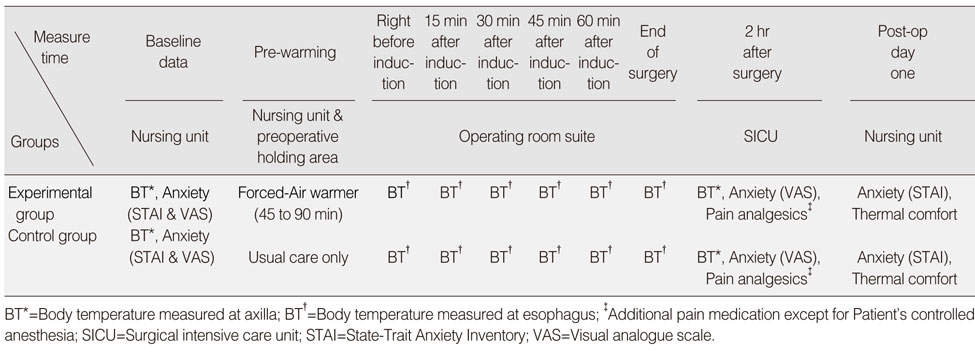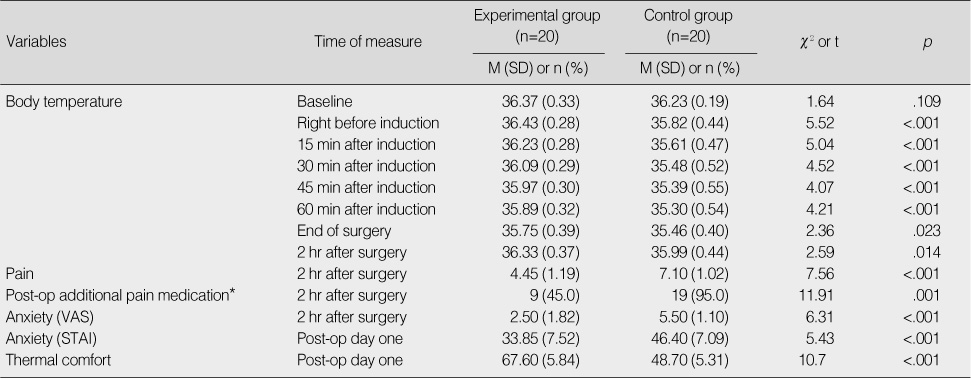Articles
- Page Path
- HOME > J Korean Acad Nurs > Volume 40(3); 2010 > Article
-
Original Article
- The Effect of Pre-warming for Patients under Abdominal Surgery on Body Temperature, Anxiety, Pain, and Thermal Comfort
- Ok Bun Park, Heejung Choi
-
Journal of Korean Academy of Nursing 2010;40(3):317-325.
DOI: https://doi.org/10.4040/jkan.2010.40.3.317
Published online: June 30, 2010
1Head Nurse, Operation Room, Konkuk University Hospital, Seoul, Korea.
2Professor, Department of Nursing, Konkuk University, Chungju, Korea.
- Address reprint requests to: Park, Ok Bun. Operation Room, Konkuk University Hospital, 4-12 Hwayang-dong, Gwangjin-gu, Seoul 143-729, Korea. Tel: 82-2-2030-5463, Fax: 82-2-2030-5422, bada@kuh.ac.kr
Copyright © 2010 Korean Society of Nursing Science
Figure & Data
REFERENCES
Citations

- The Relationship of Perioperative Inadvertent Hypothermia with Anxiety and Comfort
Zehra Bozkurt, Özlem Şahin Akboğa
Therapeutic Hypothermia and Temperature Management.2025; 15(1): 31. CrossRef - Effects of Forced-Air Warming Blanket on Anxiety Reduction and Thermal Comfort Improvement With Physical Indicators for Patients Undergoing Abdominal Surgery: A Quasi-experimental Study
Shu-Mei Wang, Chung-Ying Lin, Musheer A. Aljaberi, Chiu-Hsiang Lee, Ying-Hsiang Chou, Mark D. Griffiths
Journal of PeriAnesthesia Nursing.2025; 40(5): 1300. CrossRef - Barriers and Solutions in Implementing Evidence-Based Recommendations to Prevent Intraoperative Inadvertent Hypothermia: A Qualitative Study
Ozlem Sahin Akboga, Yesım Dikmen Aydin
Therapeutic Hypothermia and Temperature Management.2024; 14(4): 282. CrossRef - Effects of Active Heating Methods on Body Temperature, Shivering, Thermal Comfort, Pain, Nausea and Vomiting During General Anesthesia: A Randomized Controlled Trial
Özlem Şahin Akboğa, Aysel Gürkan
Therapeutic Hypothermia and Temperature Management.2024; 14(4): 269. CrossRef - Effect of Active and Passive Heating Methods Used in Different Areas of Perioperative Processes on Thermal Comfort and Anxiety: A Randomized Control Trial
Pınar TUNÇ TUNA, Şerife KURŞUN, İnci KARA
Journal of Basic and Clinical Health Sciences.2022; 6(1): 225. CrossRef - Influence of Gas Pain, Post-operative Resilience, and Body Temperature Discomfort in Laparoscopic Myomectomy Patients after Thermotherapy
JeongAe Lee, MyoungHwa Jeon, EunJu Park, JinAh Lee, GonMyoung Ahn, SeungShin Lee, JiIn Kim
Korean Journal of Women Health Nursing.2019; 25(1): 4. CrossRef - Do Warmed Blankets Change Pain, Agitation, Mood or Analgesic Use Among Nursing Home Residents?
Christine R. Kovach, Michelle Putz, Barbara Guslek, Robert McInnes
Pain Management Nursing.2019; 20(6): 526. CrossRef - Forced-Air Warming for Rewarming and Comfort Following Laparoscopy: A Randomized Controlled Trail
Hsiao-Chi Nieh, Shu-Fen Su
Clinical Nursing Research.2018; 27(5): 540. CrossRef - Effects of Forced Air Warming on Body Temperature, Shivering and Pain in Laparoscopic Cholecystectomy Patients*
Sung Joo Park, Sook Young Kim
Journal of Korean Academy of Fundamentals of Nursing.2015; 22(3): 287. CrossRef - Evaluating of Validity on Peri-operative Hypothermia Management Evidence Based Guideline
Sung-Jung Hong, Eunjoo Lee
Journal of the Korea Academia-Industrial cooperation Society.2014; 15(1): 331. CrossRef - The Effect of Hand Holding and Nei-Guan Acupressure on Anxiety and Pain under Local Anesthetic Patients during Surgery
Sun Hee Park, Hee Jung Jang
The Journal of the Korea Contents Association.2014; 14(11): 378. CrossRef - Effects of ASPAN's Evidence-based Clinical Practice Guidelines for Promotion of Hypothermia of Patients with Total Knee Replacement Arthroplasty
Je Bog Yoo, Hyun Ju Park, Ji Yeoun Chae, Eun Ju Lee, Yoo Jung Shin, Justin Sangwook Ko, Nam Cho Kim
Journal of Korean Academy of Nursing.2013; 43(3): 352. CrossRef - Effect of Pre-warming on Reducing the Incidence of Inadvertent Peri-operative Hypothermia for Patients Undergoing General Anaesthesia: A Mini-review
Lucie Llewellyn
British Journal of Anaesthetic and Recovery Nursing.2013; 14(1-2): 3. CrossRef


Figure 1
Figure 2
Homogeneity between Experimental Group and Control Group
STAI=State-Trait Anxiety Inventory; VAS=Visual analogue scale.
Mean differences in Body Temperature (℃), Anxiety, Pain and Thermal Comfort
*The number of person who was taken the additional pain medicine for 2 hr since end of surgery.
VAS=Visual analogue scale; STAI=State-Trait Anxiety Inventory.
Repeated Measure ANOVA of Intra-operative Body Temperature
STAI=State-Trait Anxiety Inventory; VAS=Visual analogue scale.
*The number of person who was taken the additional pain medicine for 2 hr since end of surgery. VAS=Visual analogue scale; STAI=State-Trait Anxiety Inventory.
 KSNS
KSNS
 E-SUBMISSION
E-SUBMISSION





 Cite
Cite

